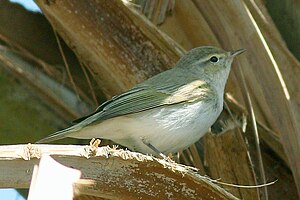Balkan warbler
| Balkan warbler | ||||||||||||
|---|---|---|---|---|---|---|---|---|---|---|---|---|

Balkan warbler |
||||||||||||
| Systematics | ||||||||||||
|
||||||||||||
| Scientific name | ||||||||||||
| Phylloscopus orientalis | ||||||||||||
| ( Brehm , 1855) |
The Balkan Laubsänger ( Phylloscopus orientalis ) is a singing bird from the genus of Laubsänger (Phylloscopus) and the family of Laubsänger-like (Phylloscopidae). No subspecies are distinguished. Together with the mountain warbler, it forms a super species . The Balkan warbler is occasionally observed in Central Europe as a rare stray visitor.
description
The Balkan Warbler was previously considered an eastern subspecies of the Mountain Warbler . In the light of more recent research results (Sangster et al. 2002, Parkin 2003) it is now usually viewed as a separate species. It is about 11 to 12 cm long - overall slightly larger than the mountain warbler. As with the mountain warbler, its upper side is grayish-brown, but has a comparatively stronger brownish tint, while the under wing-coverts and axillary feathers have a paler yellow. Males and females have the same coloration.
The call of the Balkan leaf singer is monosyllabic and harder than that of the mountain leaf singer: "Tschip" (similar to a young house sparrow), or a wooden "tüt", on the train also a quieter "eat". The song is faster than that of the mountain folk singer, reminiscent of the trill in the blue tit song.
Habitat and existence
The breeding area of the Balkan Warbler extends from the Balkans to Turkey . The Dinaric Mountains separate the range of the Balkan warbler from that of the mountain warbler. The European population is estimated at around 28,000 to 108,000 breeding pairs. Large populations live in Greece , Bulgaria and Turkey , among others .
Mainly wooded slopes are chosen as habitat - areas that would be occupied elsewhere by the related mountain warbler. The height distribution extends up to 1800 meters above sea level. The breeding area is populated from the beginning of April to September, the species winters in East Africa from Sudan to Ethiopia .
nutrition
The Balkan warbler feeds on insects .
supporting documents
literature
- Hans-Günther Bauer, Einhard Bezzel , Wolfgang Fiedler (eds.): The compendium of birds in Central Europe: Everything about biology, endangerment and protection. Volume 2: Passeriformes - passerine birds. Aula-Verlag Wiebelsheim, Wiesbaden 2005, ISBN 3-89104-648-0 .
- George Sangster, Alan G. Knox, J. Andreas Helbig, David T. Parkin: Taxonomic recommendations for European birds. In: Ibis Journal. Volume 144, No. 1, 2002, pp. 153-159, doi : 10.1046 / j.0019-1019.2001.00026.x .
- David T. Parkin: Birding and DNA: species for the new millennium. In: Bird Study. Volume 50, No. 3, 2003, pp. 223–242 ( abstract, link to full text )
Web links
- Videos, photos and sound recordings on Phylloscopus orientalis in the Internet Bird Collection